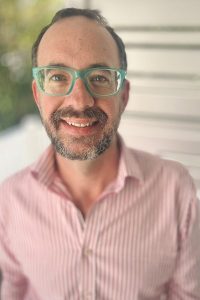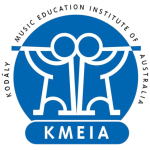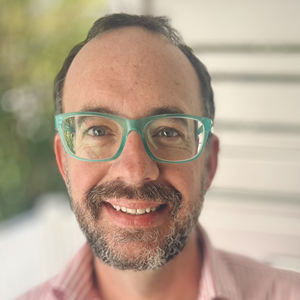 Andrew Pennay is Director of Creative Arts at Brisbane Girls Grammar School, where he implements aural-based activities to enhance composition and improvisation work. Andrew has lectured in music education at a tertiary level and has presented workshops nationally and internationally, focusing on popular music education, musicianship, upper secondary teaching methodology, and teaching for creativity and curiosity. For 12 years, he was a performer and Assistant Conductor with The Australian Voices, touring new Australian choral music globally. Andrew has received a National Award for Excellence in School Music Education through the Australian Government Quality Teacher Programme (2011) and an Award for Excellence in Australian Kodály-inspired Music Education (Innovation) in 2022. He is currently undertaking doctoral studies in songwriting pedagogy.
Andrew Pennay is Director of Creative Arts at Brisbane Girls Grammar School, where he implements aural-based activities to enhance composition and improvisation work. Andrew has lectured in music education at a tertiary level and has presented workshops nationally and internationally, focusing on popular music education, musicianship, upper secondary teaching methodology, and teaching for creativity and curiosity. For 12 years, he was a performer and Assistant Conductor with The Australian Voices, touring new Australian choral music globally. Andrew has received a National Award for Excellence in School Music Education through the Australian Government Quality Teacher Programme (2011) and an Award for Excellence in Australian Kodály-inspired Music Education (Innovation) in 2022. He is currently undertaking doctoral studies in songwriting pedagogy.
| Day | Time | Title |
|---|---|---|
| 1 | 10am | Musicianship |
| Day | Time | Title |
|---|---|---|
| 2 | Session 1: 9.50 | Dancing on the ceiling: Valuing other perspectives in the music classroom |
| As we perform, listen to, and move to music, we might well ask: What does this music say about me, as well as those around me? Let’s explore ways to leverage cultural forces so we might transform our classrooms into vantage points. Through exposure to strategies drawn from Harvard’s seminal Project Zero work, participants take a deep dive into a range of music activities that promote the valuing of their own perspectives alongside those of others. In performing and interacting with works by popular First Nations artists Thelma Plum and Baker Boy, we uncover hidden stories, back stories, and our own stories. Through “True for Who?” experiences, we reflect critically on our own assumptions about the Western canon. These key questions are investigated: How might teachers model broad perspective-taking for their students? What questioning strategies and learning opportunities are helpful in pushing students beyond the familiar? | ||
| Session 2: 11.15 | Panel: Music for All? | |
| A discussion about access to and content of music education in our schools and communities. What are barriers to music education? How do we honour the diversity of the students in front of us? What are the compromises we have to make? What are our goals for inclusive music education? | ||
| Session 3: 15.00 | Musicianship | |
| Day | Time | Title |
|---|---|---|
| 3 | Session 1 | Musicianship |
| Session 5: 15.00 | Western harmony is dead: re-constituting notions of harmony, from Confucius to Daft Punk | |
| What the world needs now is love, sweet love… and a better conceptualisation of harmony. Through a brief survey of Eastern and Western philosophical positions, both ancient and modern, it becomes possible to characterise Western notions of music harmony as narrowly defined, dated, ethno-centric, and Euro-centric. A bold re-constitution of harmony—more culturally inclusive and applicable to the broad range of musics we perform in music classrooms—helps music teachers fend off elementised, compartmentalised, constricted views of music harmony. In this practical session, we explore an alternative framework that asks students to perform and compose with greater attention to the harmonising features of music at the micro and macro level, far beyond chords and keys. After exploring prosody, music production and artist persona, we go further consider global, liberated definitions of harmony as we cultivate performance-audience relationships and the important social functions of music making. | ||
| Day | Time | Title |
|---|---|---|
| 4 | Session 1 | Musicianship |
| Session 3: 12.00 | If curiosity killed the cat, who killed curiosity? | |
| In historicising and problematising Australia’s national instinct to devalue artistic curiosity through our state-based syllabi, we must embrace a creative way forward for Kodály-based music programs in primary and secondary contexts. Ever curiouser and curiouser, and with eight lives remaining, the feline bites back in this session, providing eight strategies for embracing curiosity in the music classroom. Through the lens of Ron Ritchhart’s cultural forces, we examine our own pedagogical practices to find playful opportunities for wonder, awe and excitement when performing and responding to culturally diverse repertoire. In considering our use of time, the way we interact with students, our assessment practices, our language moves, and even our physical environment, let’s push for genuine inquisitiveness as music learners come to value historically under-represented voices. We’ve still got eight more shots at this. | ||


